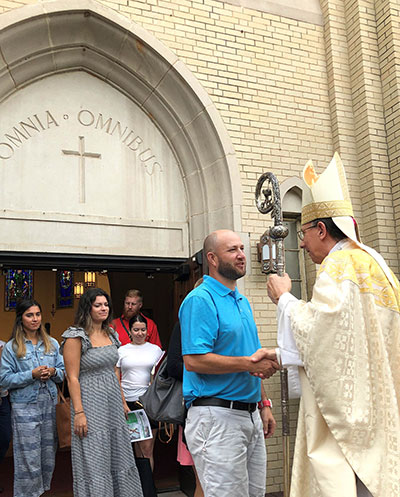 CHARLOTTE — Sunday’s celebration at St. Patrick Cathedral was a recognition of two special anniversaries for the parish, decades in the making.
CHARLOTTE — Sunday’s celebration at St. Patrick Cathedral was a recognition of two special anniversaries for the parish, decades in the making.
Bishop Peter Jugis celebrated a Mass Sept. 4 commemorating the 83rd anniversary of the church’s dedication and the 50th anniversary of its elevation to a cathedral.
St. Patrick Cathedral is the seat of the Roman Catholic Church in Charlotte, N.C., and listed on the National Register of Historic Places. Built in 1939, it is the mother church of the Diocese of Charlotte and is the seat of its bishop. It was consecrated under the patronage of
St. Patrick on Sept. 4, 1939, by Bishop Eugene J. McGuinness of the Diocese of Raleigh, which at the time covered the entire state. In 1972, when the Diocese of Charlotte was carved out of the Raleigh diocese, Charlotte Bishop-elect Michael J. Begley selected St. Patrick Church as the cathedral for the new diocese, and the church was elevated to a cathedral when the diocese was born on Jan. 12, 1972.
This year marks the 50th anniversary of the diocese’s founding, and St. Patrick Cathedral is hosting several golden anniversary events, including the opening and closing Masses of the jubilee year. The cathedral is also home to many of the diocese’s most important liturgical celebrations – including the annual Chrism Mass, in which the bishop consecrates the sacred oils used in the sacraments at every church in the diocese.
During his homily at Mass Sept. 4, Bishop Jugis touched on the history of St. Patrick Parish, created by and for the growing Irish Catholic community in what is now the Dilworth neighborhood of Charlotte.
St. Patrick’s – like any Catholic church – is dedicated to three purposes, he said.
“First of all, we build a church building for the worship of Almighty God,” he said. “The worship of Almighty God is the first duty of every human being regardless of whether they are a believer or not – to worship God who gives us life and has redeemed us.”
Second, he said, “this church building also serves a purpose of your sanctification to make you holy, to assist you on your way to eternal life. Through the sacraments that we celebrate here, through the Gospel of Christ which will be proclaimed here and preached here … you become the living body of Christ, the spiritual temple of the Holy Spirit.”
Bishop Jugis also explained that a church is also important because it serves as a visible, tangible sign of the presence of the Catholic Church in its community.
“We all are spiritual beings, we have souls, but we are also physical beings, and we need visible, tangible, physical things that speak to us,” he said.
“A church building is a sign to others that God is here. It stands as a perpetual, perennial, permanent presence to that witness. It is a sign of God’s mercy, a sign of God’s truth, a symbol of God’s holiness and a constant reminder to follow God’s ways, to live according to God’s ways.”
“On this day, the 83rd anniversary to the day of the dedication of this church to Almighty God, we do pray and give thanks to the Lord for this beautiful gift that He has given to us,” Bishop Jugis said. “And using the words He gives us in the responsorial psalm (Psalm 95): ‘Let us come before the Lord and praise Him for His goodness.’”
Concelebrating the Mass with the bishop was Father Ernest Nebangongnjoh, who serves as parochial vicar at the cathedral. The cathedral’s three deacons, Carlos Medina, Brian McNulty and Paul Bruck, assisted, along with parish altar servers and seminarians from St. Joseph College Seminary in Mount Holly.
For more information about the history of St. Patrick Cathedral, go online to www.stpatricks.org.
— SueAnn Howell. Photos by SueAnn Howell and archives











